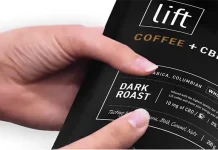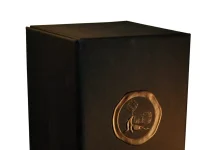By Liz Stevens, writer, PostPress
Film laminating is an option that can offer both practical, functional as well as embellishment solutions for printers and finishers. In the past, laminating has posed several challenges for a variety of reasons, but today’s equipment makers have largely tackled and overcome these challenges and have engineered advanced film laminating systems featuring the latest in automation, which makes the addition of the newest laminating equipment an attractive consideration.
PostPress talked with representatives from three leading equipment manufacturers and distributors – Best Graphics Group, Nobelus and Skandacor – to learn about emerging trends in film laminating, how new technologies can solve common laminating problems and the value-add that film laminating can provide for printers and finishers. Best Graphics Group, Waukesha, Wisconsin, offers a full line of graphic arts, bindery, finishing and packaging equipment from 20 global manufacturers. Nobelus, Knoxville, Tennessee, is a lamination system integrator and specialty films innovator. Skandacor, Webster, New York, offers laminating, binding, folding and cutting equipment and supplies.
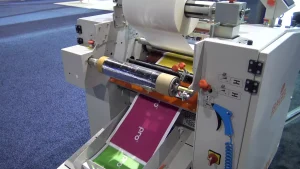
What are some of the hot markets right now for film laminating? Why has there been growth in these areas?
John Hower, marketing & business development at Best Graphics Group, identified several areas where film laminating is in demand. “One area,” said Hower, “is book publications. Book readership is at the highest it has been since 2008 and, therefore, so is book manufacturing.” Another hot market is in folding cartons and packaging. “In this sector,” Hower said, “laminating adds higher structural integrity to cartons and packaging, and this typically requires unique films. We also are seeing a lot of interest from the marijuana/CBD industry; this market is in its infancy stage. There is a high growth rate of demand from the vast number of companies vying for market control that are looking for unique packaging options.” Hower also noted increased use in the commercial sector. “Differentiation is key, right? Utilizing textured films to create a sensory experience for the end user helps companies stand out.”
Dragan Nikolic, business development manager at Nobelus, pointed to a trio of hot markets. “Prime labels,” he said, “are increasingly being utilized by major and boutique brands to engage the senses and help consumers form a connection with products. Start-up brands want to stand out and make their packaging experience more memorable. Both profiles have a growing demand for embellishments and tactile finishes on prime labels.” Nikolic highlighted the expanding opportunities in flexible packaging. “Many brands are moving to flexible packaging solutions,” said Nikolic, “to accommodate an expanding line of products and meet new standards for sustainability to leave a smaller footprint. With products like Nobelus’ line of unsupported films, flex pack manufacturers can also offer more finishes and effects than ever before.” And Nikolic noted that lamination can provide the luster formerly found in silver halide. “Because silver halide has fallen out of favor with many digital photo producers due to supply issues and price increases, a digital solution that doesn’t use traditional silver halide is of great interest,” he said. “Nobelus integrates sheet-fed and roll-to-roll lamination to replicate a silver halide luster on digital print, preserving the look and feel of a traditionally produced photo almost perfectly.”
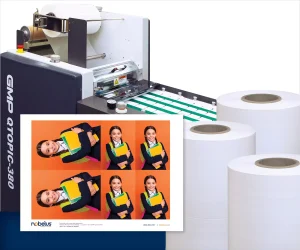
Bob Rowden, product development at Skandacor, also sees the tactile quality of film laminating creating market opportunities. “Tactile films continue to be the hottest market right now for film laminating,” he said. “Growth in this area is due to consumer demand and the realization amongst designers that film lamination is no longer just for print protection and durability, but a key component of the graphic design that can make or break the impact of the finished piece.” Rowden commented that Skandacor provides soft touch films that are very popular for their tactile feels but even more so for the special formulation that make them work as an excellent base layer for further embellishments like spot UV coatings and/or digital foils. Rowden also noted that the embossed features of one of Skandacor’s lines of films provides dimension to otherwise flat printing and can link well with the intended impact of the printed piece. “For example,” said Rowden, “Skandacor offers an authentic woodgrain pattern that totally transforms a hardwood furniture marketing piece, giving the visual impact of real wood.”
What challenges are there currently with film laminating applications? What technology does your equipment have to overcome these challenges?
“Digital print,” said Rowden, “has always been a challenging application for film lamination, however progress in film and equipment technology have overcome this, with our UltraGrip adhesives for the films and improved heat and pressure systems on the equipment. It is common to see infrared heaters in the industry, but the issue surrounding infrared heat with air is that the hot air quickly dissipates. Our technology utilizes sealed system liquid heaters which maintain the heat much more effectively, eliminating cold cycles and reducing energy consumption.”
“Another common challenge,” Rowden said, “is producing sheets that are suitable for downstream processing through finishing equipment, with curl and lamination flagging being the most common culprits when issues arise. Design improvements to decurling, cooling the sheet under tension and sheet separation all play key roles in getting
effective output.”
Nikolic brought up rising costs and supply chain issues. “It can be hard for PSPs to keep up with increasing supply chain and cost pressures in lamination,” he said. “In a time when raw material and freight costs are constantly rising, we’ve found some ways to help our customers employ more creative solutions. For instance, we’ve discovered that we can help converters create foil board on-demand with our metalized silver, gold and holographic laminates. This can save money on several fronts: cost of finished material, scaling down paper weight and carrying zero inventory.”
“Another challenge for PSPs,” said Nikolic, “is knowing which adhesives and laminates are compatible with emerging printing technologies and the various inks they use. Nobelus is currently addressing this issue by offering adhesives designed specifically for digital inks – in addition to our traditional adhesives – but we also fund research and development to discover more comprehensive solutions, such as equipment features that can increase bond strength and adhesives that work with any type of ink.”
In Hower’s experience, the primary challenge is that finishers and printers want to offer a wider range of solutions or applications to end users. “Printers can overcome this challenge by using technology that allows them to choose from multiple film materials,” he said. “The hot-knife capability that our equipment offers allows printers to utilize a wider variety of films, such as polypropylene, nylon, polyester and metalized films.”
What advantages does your film laminating equipment offer to the companies looking to add film laminating to their services offering?
“At Best Graphics Group,” said Hower, “our Ecosystem Film Laminators have a wide breadth of offerings, from short run, small format digital offerings to high volume, long run work, to roll-to-roll water-based solutions. Simply put, there is no single-sided application or price point that we cannot fulfill.”
Nikolic said that automation, a range of production capacity and options make Nobelus equipment attractive. “Labor shortages are making automation more vital than ever,” said Nikolic, “and Nobelus’ extensive catalog of automated systems ensures PSPs get products to market on time while still adding value to finished print. We offer units that can support production volumes ranging from medium to extremely high and have single-sided and dual-sided options.”
Rowden also cited automation. “With an aging workforce being replaced by younger digital-first workers, as well as skilled labor shortages,” he said, “we strive to make our equipment easy to use. A popular feature of Skandacor’s commercial lineup is its automation, allowing the machines to be started with just one button and graphical icon-based user interfaces with touch screens that make job setup intuitive. Time is money, so quick set-up and effective operation have become the most important aspects.”
Equipment design and durability, said Rowden, are also prime features for Skandacor. “Shorter runs and higher customer expectations regarding fast turn times have brought the cost of downtime into sharp focus,” he said. “We’ve analyzed build quality component-by-component to address any weak links in the systems and to eliminate unnecessary design features, while keeping overall machine performance front and center. By stepping back from the competing options and taking a systematic, user-first approach to the machine design, our equipment far surpasses any others in the market, making Skandacor the machines of choice for progressive printers looking for well-built, versatile and compact machines.”
Many of our readers are involved with trade/print finishing services. Do you have any comments on why you believe a finishing operation should consider adding or upgrading their film laminating capabilities?
Nikolic said that finishers can benefit by adding laminating for a choice of finish/embellishment and speedy production. “Getting prints to market quickly is pivotal in giving trade finishers an advantage over the competition,” said Nikolic, “and this requires updated equipment that can optimize the lamination process for improved productivity. Having modern sheet-fed and roll-to-roll lamination equipment in-house also enables trade finishers to offer a broader variety of finishing services and to supply their customers with more options for finishes and embellishments, resulting in higher profit margins.”
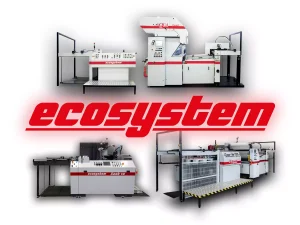
Rowden stressed that lamination and specialty finishes are becoming increasingly popular and that with the Great Retirement, shops may want to replace older equipment with new, automated machinery. “Since lamination complements and often is required as part of overall print embellishment, shops without film lamination capability will find it hard to compete as print consumer demands change,” said Rowden. “The growth of the packaging segment also is driving demand for film lamination. For those looking to upgrade, we often find that automation and ease of use are primary drivers as skilled labor retires. Older mechanical equipment is difficult to find operators for and harder to maintain. Also, increased versatility and the ability to apply specialty finishes like digital foils and coatings have driven adoption of
newer technology.”
Hower asserted that for finishers, “film lamination is a further embellishment or offering for users. The ability to offer film lamination is proven to engage the customer and increase margins. Being able to provide film lamination in-house makes for decreased lead times for finishers and gives them increased quality control on the products they produce.”
All three of these equipment providers will be exhibiting live at Amplify, the print finishing & embellishment event taking place June 14 – 16, 2022, in Minneapolis, Minnesota. For more information on Amplify, visit www.amplifyprint.org.



